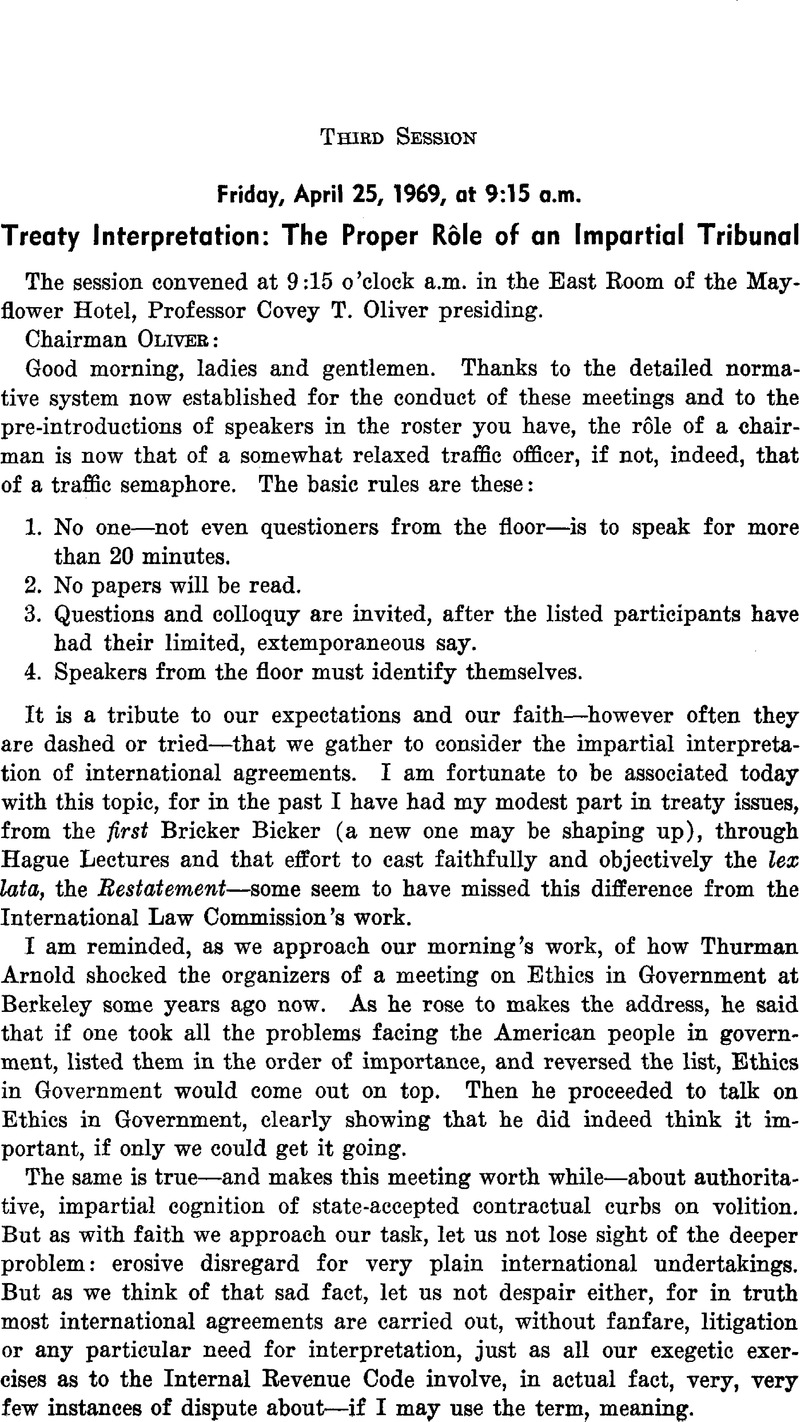No CrossRef data available.
Article contents
Treaty Interpretation: The Proper Rôle of an International Tribunal
Published online by Cambridge University Press: 27 February 2017
Abstract

- Type
- Perspectives for International Legal Development
- Information
- Proceedings of the American Society of International Law at its annual meeting (1921-1969) , Volume 63 , 1969 , pp. 107 - 122
- Copyright
- Copyright © American Society of International Law 1969
References
1 Joint Dissenting Opinion of Judges Lauterpacht, Wellington Koo and Spender in the Aerial Incident Case, I.C.J. Eeports 1959, p. 127, at 191.
2 The Cameroons Case, I.C.J. Eeports 1963, p. 15, at 38. See Leo Gross, “Limitations upon the Judicial Function,” 58 A.J.I.L. 415–431 (1964).
3 The Development of International Law at 91 (1958).
4 The Prospects of International Adjudication at 666–667 (1964). See also I Rosenne, The Law and Practice of the International Court at 118–119, and 310, note 1; and I I Ibid. 606–607 (1965).
5 The Interpretation of Agreements and World Public Order at 384 (1967).
6 Rosenne, note 4 above, at 607.
7 Op. cit. note 5 above, at 390; see also pp. 64, 265, 270.
8 A good example of this is the Guardianship case in which Judge Lauterpacht arrived at the operative clause by quite a different reasoning than the Court. I.C.J. Eeports 1958, p. 55, at 79. In this connection the Membership case may be mentioned in which two judges voted for the conclusion of the Court but showed in their separate opinions that they disagreed not only with the reasoning but with the conclusion as well. See Leo Gross, “Election of States to United Nations Membership,” 1954 Proceedings, American Society of International Law 37–59, at 45.
9 I.C.J. Reports 1969, p. 3, at 44; 63 A.J.I.L. 591 (1969).
10 See Ambassador Arthur Goldberg's statement of Aug. 16, 1965, 53 Department of State Bulletin 454 at 456 (1965); 60 A.J.I.L. 104 (1966).
11 I.C.J. Reports 1950, p. 128, at 161–162 (italics supplied). See also Leo Gross, “The International Court of Justice and the United Nations,” 120 Hague Academy of International Law, Eecueil des Cours at 385–387 (I, 1967).
12 Joint Dissenting Opinion of Judges Lauterpacht, Wellington Koo and Spender in the Aerial Incident case (Preliminary Objections), I.C.J. Eeports 1959, p. 127, at 173.
13 I.C.J. Beports 1959, p. 127, at 156, 168, 178, 183, 184, 191.
14 Ibid. at 170. For an analysis of this case see Leo Gross “The Jurisprudence of the World Court: Thirty-Eighth Year (1959),” 57 A.J.I.L. 751–780, at 753–766 (1963).
15 De Visscher, Theory and Reality in Public International Law at 99 (1957).
16 Report of the International Law Commission on the Work of the Second Part of its Seventeenth Session, General Assembly, 21st Sess., Official Records, Supp. No. 9 (A/6309/Rev.l), reproduced in 61 A.J.I.L. 248, at 271–272 (1967). (Hereinafter cited as I.L.C. Eeport.)
17 For the text of these articles as adopted by the Committee of the Whole of the U.N. Conference on the Law of Treaties, see Doc. A/Conf. 39/C.l/L.370/Add. 1–7. Arts. 50 and 61 were adopted in a modified form. For the texts of Arts. 27 and 28 (re-numbered 31 and 32) adopted by the Vienna Conference on May 23, 1969, see Doc. A/Conf. 39/27, pp. 16–17.
18 The relevant texts are conveniently reproduced with comments in Bosenne, “Interpretation of Treaties in the Restatement and the International Law Commission's Draft Articles: A Comparison,” 5 Columbia J. of Transnat. Law 205–212 (1966).
19 Rosenne, loc. cit. at 226–229.
20 Delimitation of the Czechoslovak-Polish Frontier (Question of Jaworzina), Advisory Opinion No. 8, Dee. 6, 1923, Series B, No. 8, pp. 6–57 at 37. See also De Visscher, Problemes d'Interprétation Judiciaire en Droit International Public at 20 (1963).
21 See Doc. A/CONF.39/C.1/L.370 at 140, par. 10. See also Bosenne, note 18 above, at 212 ff.
22 Doc. A/CONF.39/C.1/L.370 at 139, par. 8.
23 I.L.C. Report at 354, par. 10. Rosenne prefers the arrangement of the Restatement; see note 18 above, at 222.
24 McDongal, “International Law Commission's Draft Articles upon Interpretation; Textuality Redivivus,” 61 A.J.I.L. 992–1000, at 995 and 998, note 30 (1967),
25 North Sea Continental Shelf Cases, I.C.J. Eeports 1969, p. 3, at 32.
26 Lauterpacht, note 3 above, at 130–134.
27 Note 24 above, at 999.
28 Op. cit. note 5 above, at 390. Professor McDougal wrote: “The great defect, and tragedy, in the International Law Commission's final recommendations about the interpretation of treaties is in their insistent emphasis upon an impossible, conformity-imposing textuality.” Loc. cit. note 24 above, at 992.
29 Rosenne, note 18 above, at 229.
30 I.L.C. Beport at 354, par. 11 (italics added). See also De Visscher, note 20 above, at 53, and Max Huber's remarks there quoted in note 1.
31 Metzger, “Treaty Interpretation and the United States-Italy Air Transport Arbitration,” 61 A.J.I.L. 1007 at 1011 (1967). In that ease the tribunal started with the text and continued with the context, the subsequent practice and related factors bearing on the situation of the parties, all of which supported the analysis of the “ordinary meaning” of the text. Ibid, at 1009.
32 Note 24 above, at 998, note 30.
33 Report of the International Court of Justice, Aug. 1, 1967-July 31, 1968, General Assembly, 23rd Sess., Official Eecords, Supp. No. 17 (A/7217), p. 3.
34 Signed at Wellington, July 12, 1967. 6 Int. Legal Materials 736 (1967).
35 As the Commission stated: “In addition the establishment of some measure of agreement in regard to the basic rules of interpretation is important not only for the application but also for the drafting of treaties.” I.L.C. Eeport, par. 5, at 351. This expectation is shared by the authors of the New Haven study, note 5 above, at 393.
36 Note 5 above, at 363.
37 Professor McDougal's Statement on behalf of the United States Delegation, to the Committee of the Whole, April 19, 1968, 62 A J J i . 1021–1027 at 1025 (1968).


